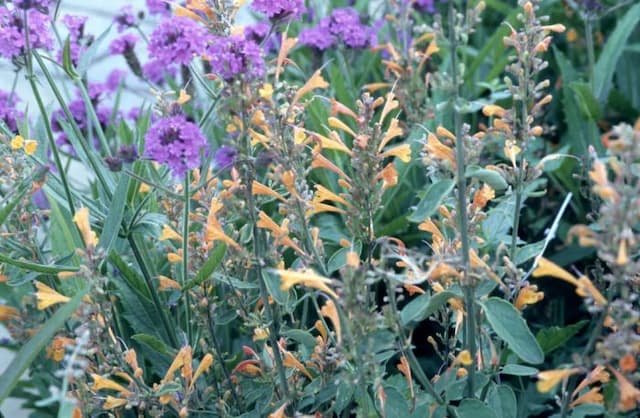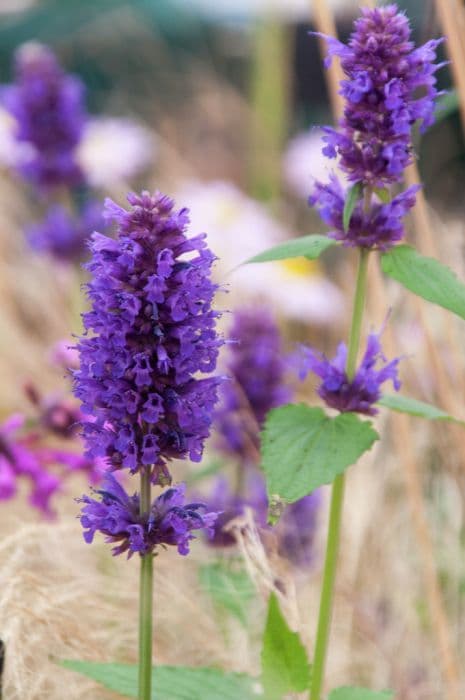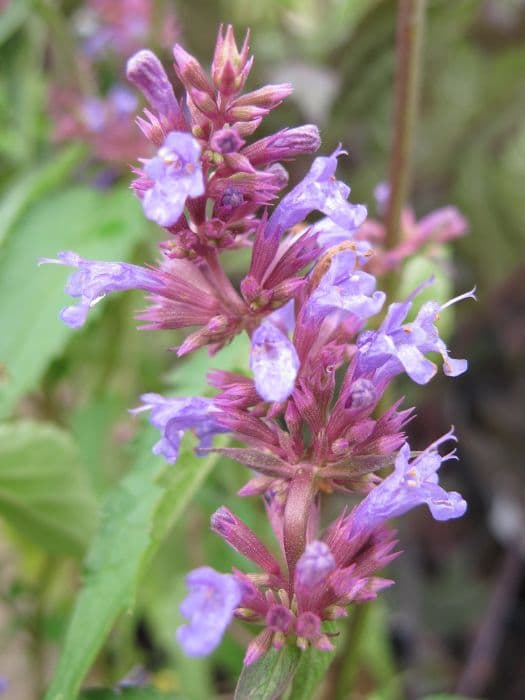Woolly lavender Lavandula lanata

ABOUT
L. lanata is an evergreen dwarf shrub to 75cm tall, with white-woolly stems and leaves, and dark purple flowers in long-stemmed aromatic spikes
About this plant
 Names
NamesFamily
Lamiaceae
Synonyms
Woolly Lavender
Common names
Lavandula lanata
 Characteristics
CharacteristicsLife cycle
Perennials
Foliage type
Evergreen
Color of leaves
Gray-green
Flower color
Violet
Height
2 feet (0.61 meters)
Spread
2 feet (0.61 meters)
Plant type
Shrub
Hardiness zones
8
Native area
Mediterranean
Benefits
 General Benefits
General Benefits- Ornamental Appeal: Lavandula lanata, commonly known as woolly lavender, possesses silver-hued foliage and vibrant purple flowers, adding aesthetic value to gardens and landscapes.
- Aromatic Fragrance: The plant emits a pleasing and strong scent that is appreciated in gardens and can be used in potpourris.
- Drought Tolerance: Woolly lavender is well adapted to dry conditions, making it a suitable choice for water-wise gardens.
- Pollinator Attraction: The flowers attract bees, butterflies, and other beneficial pollinators, supporting local ecosystems.
- Low Maintenance: It typically requires minimal care once established, making it a convenient option for gardeners of all skill levels.
- Culinary Uses: Though not all Lavandula species are edible, some parts of woolly lavender may be used to flavor certain dishes, imparting a unique taste.
 Medical Properties
Medical Properties- Anti-inflammatory: Lavandula lanata may possess compounds that could reduce inflammation.
- Antiseptic: The plant's essential oils might have properties that can help to prevent the growth of microorganisms.
- Analgesic: There is potential for the plant to be used for pain relief.
- Anxiolytic: Compounds in Lavandula lanata might be beneficial in reducing anxiety.
- Sedative: It may have mild sedative effects that could help with sleep disorders or restlessness.
 Air-purifying Qualities
Air-purifying QualitiesThis plant is not specifically known for air purifying qualities.
 Other Uses
Other Uses- Lavender (Lavandula lanata) can be used in crafts such as making lavender sachets, which provide a natural fragrance to drawers and closets.
- This plant can be added to potpourris alongside other dried flowers to create a long-lasting and pleasant aroma in your home.
- Lavender is often incorporated into homemade soaps for its fragrant properties and attractive appearance when used as a decorative element.
- The fuzzy leaves of Lavandula lanata can be used in floral arrangements, adding a unique texture and contrast to bouquets.
- Dried lavender stems can be bundled and used as a natural and aromatic fire starter for fireplaces or campfires.
- The flowers can be used to infuse oils or vinegars, imparting the subtle flavors and scents of lavender to cooking and dressing recipes.
- By placing dried lavender under pillows or inside pillowcases, it can act as a natural sleep aid, promoting relaxation through its scent.
- As a natural dye, the flowers of Lavandula lanata can be used to dye fabrics or yarns in shades of blue, grey, and purple.
- Lavender can be used in homemade candles to provide a calming aroma when the candle is burned.
- The plants can also act as a natural insect repellent when planted in gardens or when the oil is applied to the skin.
Interesting Facts
 Feng Shui
Feng ShuiThe plant Lavender is used in Feng Shui to promote calm, relaxation, and cleanliness in a space. It is often recommended to place lavender in the bedroom or any area of the home where you want to encourage a peaceful and restful atmosphere, as its scent is believed to have a calming effect on the mind and body.
 Zodiac Sign Compitability
Zodiac Sign CompitabilityThe plant Lavender is not used in astrology practice.
 Plant Symbolism
Plant Symbolism- Peace and Tranquility: Due to its calming scent, the woolly lavender (Lavandula lanata) is often associated with peace and tranquility. It is believed to reduce stress and promote a serene environment.
- Healing: Historically, lavender is linked to healing properties, both physical and emotional. Woolly lavender's essential oils are thought to have therapeutic effects.
- Purity: The clean and fresh fragrance of woolly lavender suggests purity and cleanliness, making it a symbol of innocence and virtue.
- Devotion: The enduring nature of lavender's fragrance has made it a symbol of loyalty and devotion in relationships.
- Protection: Lavender is sometimes used in protective sachets to ward off evil spirits. Woolly lavender could be included in such customs, signifying safety and protection.
 Water
WaterWooly lavender should be watered sparingly as it is drought-tolerant and thrives in dry conditions. It is best to water the plant once every two weeks with about a half gallon per plant, ensuring the soil is well-drained to prevent root rot. During the hot summer months, you may need to water wooly lavender slightly more often; however, always check the soil moisture before watering. Over-watering can be detrimental, so let the soil dry out between watering sessions.
 Light
LightWooly lavender requires full sun to flourish, meaning at least 6 to 8 hours of direct sunlight per day. It should be placed in a south-facing location if grown indoors or in an area that receives ample sunlight if planted outside. The best spot for wooly lavender is a sunny, open area without shade to ensure robust growth and optimal oil production.
 Temperature
TemperatureWooly lavender thrives in a temperature range between 60 to 70 degrees Fahrenheit but can tolerate temperatures down to 10 degrees and up to 100 degrees Fahrenheit. It is important to provide good airflow, especially in hot, humid climates, to keep the temperature around the plant stable. Wooly lavender prefers cooler night temperatures, which help to promote healthy growth.
 Pruning
PruningWooly lavender should be pruned annually to maintain its shape and encourage fresh growth. Pruning is best done in the spring, just as new growth is beginning, and again after flowering to shape the plant and prevent it from becoming leggy. Remove up to a third of the plant, cutting just above the new growth to promote bushier growth. Pruning not only improves the appearance but also stimulates new blooms.
 Cleaning
CleaningAs needed
 Soil
SoilWoolly Lavender requires well-draining soil with a gravelly or sandy texture, often achieved with a mix of two parts coarse sand, one part perlite, and one part compost. The ideal soil pH for Woolly Lavender is between 6.5 and 7.5.
 Repotting
RepottingWoolly Lavender should be repotted every two to three years to refresh the soil and accommodate root growth. Use a slightly larger pot each time to ensure enough space for development.
 Humidity & Misting
Humidity & MistingWoolly Lavender prefers a dry atmosphere and does well in low humidity conditions, which mimic its native Mediterranean environment. High humidity levels should be avoided to prevent fungal diseases.
 Suitable locations
Suitable locationsIndoor
Place Woolly Lavender near a sunny window and ensure good air circulation.
Outdoor
Plant Woolly Lavender in full sun and well-draining soil; shelter from harsh winds.
Hardiness zone
8-9 USDA
 Life cycle
Life cycleThe life cycle of Lavandula lanata, commonly known as woolly lavender, begins with seed germination, which occurs in warm, well-draining soil and is facilitated by full sunlight. After germination, the seedling establishes a root system and produces its first leaves, entering the vegetative stage where it focuses on growth and development. As the plant matures, it enters the flowering stage, usually in late spring to summer, producing tall spikes covered with small, purple, fragrant flowers that attract pollinators such as bees and butterflies. Following pollination, the flowers develop into seed capsules, and once the seeds are mature, they are dispersed by wind or other means, ready to begin a new cycle. During the late summer or fall, the plant may enter a period of dormancy, especially in cooler climates, where growth slows down or ceases temporarily. In regions with mild winters, woolly lavender may remain evergreen and continue growth, with proper care and conditions allowing it to live and flower for several years.
 Propogation
PropogationPropogation time
Spring to summer
Propogation: Lavandula lanata, commonly known as woolly lavender, is best propagated through semi-hardwood cuttings. This process typically takes place during the late summer. To propagate woolly lavender, a gardener should select a healthy, non-flowering stem and cut a 4 to 6-inch (10 to 15 cm) length. The lower leaves of the cutting should be removed, and the cut end can be dipped in rooting hormone to encourage root growth. The cutting is then placed in a well-draining soil mix, often composed of equal parts peat and perlite or sand. The environment should be kept humid, for instance by covering the cutting with a plastic bag or placing it in a propagator, and the soil moist but not waterlogged. Roots generally form within a few weeks, after which the new plant can gradually be acclimatized to less humid conditions before being transplanted to its final location.







![Bugle [Black Scallop]](/_next/image?url=https%3A%2F%2Fplants-admin.emdemapps.com%2Fimages%2Fplants%2F%2Fimages%2F604b624330cd1.png&w=640&q=75)

